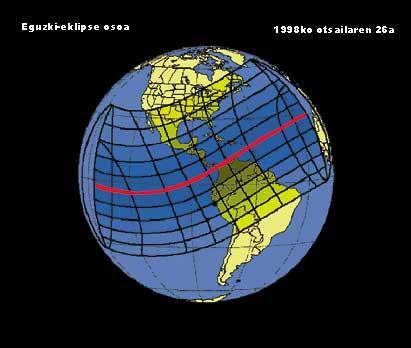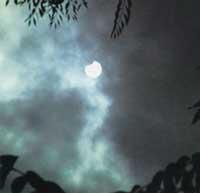XX. Last eclipse of the Sun on the Internet of the 20th century

On February 26, 1998, there was a total eclipse of the Sun that could be seen in its entirety in a strip of 140 km wide by thousands of kilometers long (see figure). The event will begin in the Pacific, after touring the Galapagos Islands, from Panama enters South America and its influence extends to Colombia and Venezuela, reaching the Caribbean Sea. It will then extend to the islands of Aruba, Curacao (former Dutch Antilles), Montserrat, Antigua and Guadalupe (the latter French territory). Then you will depart to the Atlantic Ocean to finish near the Canary Islands.
Here it can be seen as an advanced partial eclipse at sunset. The eclipse can also be observed from the Iberian Peninsula, but only at the entrance of the Sun and from certain areas: northwest (Galicia), Extremadura and southwest Andalusia, although visibility will be limited due to the partial concealment of the solar disk.
In the attached map you can see the territories where you can observe the eclipse from Earth. That is, it can only be seen from the narrow central strip. On both sides of it light will spread and it will limit with the areas that can be seen as a partial eclipse. The parallels to the line that will be seen as a whole are in percentage on the map and their function is to represent the fraction of the Solar Diameter that will be covered with these aspects. The hours, expressed by ut (universal time unit), indicate when the maximum eclipse occurs in a given place.

Thanks to this fascinating event the Eclipse’98 project has been launched. The main objective of this project is the direct transmission through the World Wide Web of the Total Eclipse of the Sun that will take place on February 26, 1998, in order to offer it to everyone, and in particular to children and young people from all over the planet, without forgetting the houses that house schools, libraries or computers that can come into contact with WWW. In this way, a unique opportunity will be offered to follow and enjoy in a comfortable and simple way the spectacular development of one of the most beautiful shows of Nature.
A network of observers located in the total eclipse line, supported by the camcorder, mobile computer and communication systems, will send the images directly to the control center. All other “mirror” addresses will be available to send the event across the web. For the observer located in the line of maximum visibility, although the phenomenon will last less than 4 minutes, at www, the duration per combination will be more than 30 minutes.

In addition, due to the didactic objective pursued by the project, in the same web address you can find games of different types and technologies, including experiences in the form of virtual reality and special videos in 3D.
Also, through the satellites of the GOES series will be offered a series of images of natural duration from the space, which can be accompanied by the control of a Rocoso Solar Telescope.
The project team consists of programmers (Microsoft), engineers, graphic designers, astronomers (Stanford University) and amateur specialists.
As the language used in Live’98 is English, the most important sections of the web address are being castellanized.
After the eclipse, in the same direction you will find films, photographs and observations of the eclipse obtained by the participants in the Eclipse’98 project.
The web address of the Live eclipse’98 project is:
http://www.staigerland.com/live98/eclipse
To see, thanks to the advances, XX. You can enjoy watching the last Sun eclipse of the 20th century.





